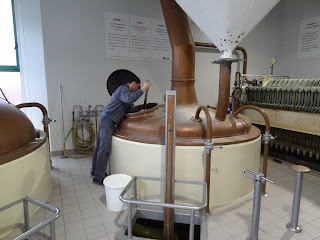___________
First the facts, ma'am:
In April, the Bavarian glassmaker Spiegelau will release the world’s first glass designed specifically for India Pale Ales, whose hops-heavy brewing process gives them an especially pungent, fruity aroma.It's the brainstorm of Spiegelau's Matt Rutkowski, whose thinking on glassware produced what can only be described as the ugliest champagne glass on earth--to which the IPA glass bears a family resemblance. Well, never mind, tasting panelists at both Dogfish Head and Sierra Nevada independently agreed that of 12 different designs, this one was the best. The new glass also earns kudos from MBAA's Karl Ockert as a flavor-maximizer.Designed in collaboration with Dogfish Head and Sierra Nevada--two craft brewers known for their IPAs--the unusual glass features wave-like ridges toward the bottom that help bring out the beer’s flavor. “As you’re tilting your glass against your face, it creates more resistance to the liquid, which pushes more carbon dioxide gas and hop aromatics out of the liquid and into the balloon-shaped chamber of the upper glass,” explains Dogfish founder and CEO Sam Calagione.
Thoughts
There are those who believe glassware affects a beer's flavor and those who don't. I am in the believer camp. I have experienced an aroma-deadening effect in the shaker pint as compared to an identical beer poured into a tulip pint. (The English nonic pint is fine, but not as nice as the tulip.) Beer glasses can affect the behavior of a beer, as when a hyper-carbonated Belgian is poured into a goblet, allowing the head to dissipate as the beer enters the glass, or a weiss vase, which encourages a lovely, thick head. Furthermore, we know that flavor is actually the play of complex inputs in the mouth and nose, including nerves in the mouth that sense pressure and viscosity, retronasal aroma, and the brute sense of taste from the taste buds. To the extent glassware can affect aroma and texture, it will affect perception of flavor.

I am also a huge fan of branding. Even if glassware had no effect on flavor, I'd love the differences in vessels--the tulip glasses that evoke Belgian beer, the steins of Germany, and hell, even our terrible shaker pints, which are so classically American. Dimpled mugs, pokals, pilsner flutes--they all suggest a beer and a place. Wonderful.
But this IPA glass fails on one of the most important dimensions--appearance. It's just embarrassing. I have really tried to love the Sam Adams glass, another engineered vessel that uses every trick in the book to boost flavor. Like the IPA glass, though, it's faintly ridiculous. There's a kind of technical fussiness, blind to the realities of aesthetics, that results in really visual absurdity. The IPA glass looks like a creation of Dr. Seuss--and not in a good way. Curves are nice, but these are childish--they don't flow elegantly, they bulge foolishly, like the bubbles protecting the Michelin man.
When machine-made clear glassware first hit the scene in the 19th century, it helped popularize pale beers. Why? Because it showcased their appearance. Ever since, proprietary glassware had focused at least in part on highlighting the beer itself. A long, slender pilsner glass is nothing special to look at itself, but it displays the beer gorgeously. When we drink a beer, our minds are working overtime to affect our sense of flavor, too. Even the concept of flavor is one more evolved in humans than any other animal, and is a fusion of tons of mental and sensory inputs. In a laboratory setting, it may be that my mind could filter out the "extraneous" notions of form and shape and verify that the new IPA glass produces the richest flavor. But in a pub, I'd just feel silly with this glass. IPAs are quickly becoming the classic American beer and they deserve their own glass. But not this one.







.JPG)

.JPG)
.JPG)






.jpg)

